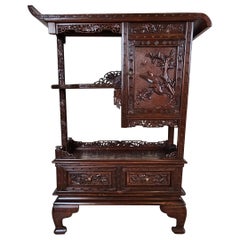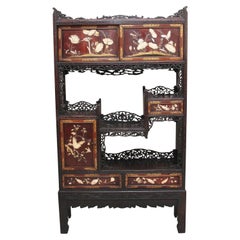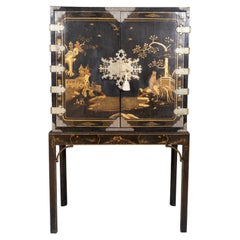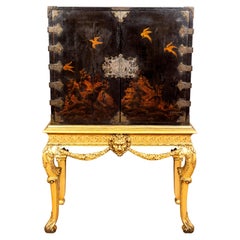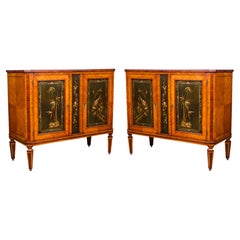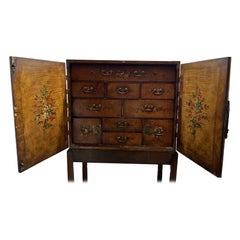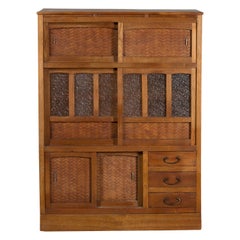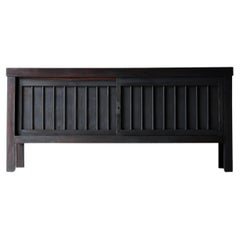Japanese Antique Cabinet
Late 19th Century Japanese Japanese Antique Cabinet
Wood
1880s Japanese Meiji Japanese Antique Cabinet
Hardwood
1770s English George III Japanese Antique Cabinet
Wood, Lacquer
1720s English George I Japanese Antique Cabinet
Wood
Early 19th Century European Neoclassical Revival Japanese Antique Cabinet
Satinwood, Lacquer
Mid-19th Century Austrian Neoclassical Revival Japanese Antique Cabinet
Brass
1870s Japanese Meiji Japanese Antique Cabinet
Iron
Early 20th Century Japanese Japanese Antique Cabinet
Rattan, Glass, Wood
Late 19th Century Japanese Meiji Japanese Antique Cabinet
Wood, Cedar, Cherry, Pine
Late 19th Century Japanese Folk Art Japanese Antique Cabinet
Wood, Cypress
Late 19th Century Japanese Meiji Japanese Antique Cabinet
Iron
1920s Japanese Anglo-Japanese Japanese Antique Cabinet
Cherry
Early 20th Century Japanese Bohemian Japanese Antique Cabinet
Fruitwood
Mid-19th Century French Chinoiserie Japanese Antique Cabinet
Wood
Early 20th Century Japanese Japanese Antique Cabinet
Wood
Early 20th Century Japanese Taisho Japanese Antique Cabinet
Wood
1880s Japanese Meiji Japanese Antique Cabinet
Wood
Late 19th Century Japanese Edo Japanese Antique Cabinet
Wood, Lacquer
1880s Japanese Meiji Japanese Antique Cabinet
Hardwood
1920s Japanese Showa Japanese Antique Cabinet
Softwood
19th Century Japanese Anglo-Japanese Japanese Antique Cabinet
Brass
1870s Japanese Meiji Japanese Antique Cabinet
Elm
Early 20th Century Japanese Anglo-Japanese Japanese Antique Cabinet
Metal
Mid-18th Century Japanese Edo Japanese Antique Cabinet
Wood, Lacquer
Early 20th Century Japanese Taisho Japanese Antique Cabinet
Iron
Early 20th Century Japanese Taisho Japanese Antique Cabinet
Wood
Early 20th Century Japanese Showa Japanese Antique Cabinet
Cypress
16th Century Japanese Antique Cabinet
Wood, Hardwood
Early 20th Century Japanese Meiji Japanese Antique Cabinet
Iron
Early 20th Century Japanese Meiji Japanese Antique Cabinet
Cedar
Early 20th Century Japanese Meiji Japanese Antique Cabinet
Iron
Early 20th Century Japanese Meiji Japanese Antique Cabinet
Cedar
17th Century Japanese Edo Japanese Antique Cabinet
Giltwood, Lacquer
Early 20th Century Japanese Japanese Antique Cabinet
Glass, Wood
Early 20th Century Japanese Japonisme Japanese Antique Cabinet
Brass
Early 20th Century Japanese Meiji Japanese Antique Cabinet
Cedar
Early 20th Century Japanese Japanese Antique Cabinet
Wood
Early 20th Century Japanese Taisho Japanese Antique Cabinet
Cedar
Late 19th Century Japanese Meiji Japanese Antique Cabinet
Iron
Early 20th Century Japanese Meiji Japanese Antique Cabinet
Cedar
Early 18th Century English George I Japanese Antique Cabinet
Lacquer
Early 20th Century Japanese Antique Cabinet
Teak
1920s Japanese Taisho Japanese Antique Cabinet
Wood
Early 20th Century Japanese Showa Japanese Antique Cabinet
Fruitwood
Early 19th Century Japanese Meiji Japanese Antique Cabinet
Iron
1780s English Georgian Japanese Antique Cabinet
Oak
Late 19th Century English Anglo-Japanese Japanese Antique Cabinet
Walnut
Early 20th Century Japanese Taisho Japanese Antique Cabinet
Wood
Late 19th Century Japanese Meiji Japanese Antique Cabinet
Iron
Early 20th Century Japanese Taisho Japanese Antique Cabinet
Brass
Early 20th Century Japanese Meiji Japanese Antique Cabinet
Iron
Early 20th Century Japanese Taisho Japanese Antique Cabinet
Cedar
19th Century Japanese Japanese Antique Cabinet
Wood
Early 20th Century Japanese Taisho Japanese Antique Cabinet
Wood
Late 19th Century Japanese Meiji Japanese Antique Cabinet
Iron
Early 20th Century Japanese Japanese Antique Cabinet
Iron
Early 20th Century Japanese Taisho Japanese Antique Cabinet
Wood, Cherry, Cedar
Mid-19th Century Japanese Japanese Antique Cabinet
Iron
- 1
- ...
Japanese Antique Cabinet For Sale on 1stDibs
How Much is a Japanese Antique Cabinet?
Finding the Right Storage-case-pieces for You
Of all the vintage storage cabinets and antique case pieces that have become popular in modern interiors over the years, dressers, credenzas and cabinets have long been home staples, perfect for routine storage or protection of personal items.
In the mid-19th century, cabinetmakers would mimic styles originating in the Louis XIV, Louis XV and Louis XVI eras for their dressers, bookshelves and other structures, and, later, simpler, streamlined wood designs allowed these “case pieces” or “case goods” — any furnishing that is unupholstered and has some semblance of a storage component — to blend into the background of any interior.
Mid-century modern furniture enthusiasts will cite the tall modular wall units crafted in teak and other sought-after woods of the era by the likes of George Nelson, Poul Cadovius and Finn Juhl. For these highly customizable furnishings, designers of the day delivered an alternative to big, heavy bookcases by considering the use of space — and, in particular, walls — in new and innovative ways. Mid-century modern credenzas, which, long and low, evolved from tables that were built as early as the 14th century in Italy, typically have no legs or very short legs and have grown in popularity as an alluring storage option over time.
Although the name immediately invokes images of clothing, dressers were initially created in Europe for a much different purpose. This furnishing was initially a flat-surfaced, low-profile side table equipped with a few drawers — a common fixture used to dress and prepare meats in English kitchens throughout the Tudor period. The drawers served as perfect utensil storage. It wasn’t until the design made its way to North America that it became enlarged and equipped with enough space to hold clothing and cosmetics. The very history of case pieces is a testament to their versatility and well-earned place in any room.
In the spirit of positioning your case goods center stage, decluttering can now be design-minded.
A contemporary case piece with open shelving and painted wood details can prove functional as a storage unit as easily as it can a room divider. Alternatively, apothecary cabinets are charming case goods similar in size to early dressers or commodes but with uniquely sized shelving and (often numerous) drawers.
Whether you’re seeking a playful sideboard that features colored glass and metal details, an antique Italian hand-carved storage cabinet or a glass-door vitrine to store and show off your collectibles, there are options for you on 1stDibs.
- 1stDibs ExpertAugust 8, 2024To tell if your Japanese pottery is antique, look for markings, which usually appear on the bottoms of pieces. If you see the word "Nippon," your piece was likely produced between 1891 and 1921, making it an antique. Pieces marked with the words "made in occupied Japan" originated between 1945 and 1952 and are vintage, based on their age. A "made in Japan" marking may indicate a vintage or contemporary piece. If you don't see any of these markings, consult trusted online resources to get a rough idea of when your pottery was produced. Any piece that dates back 100 years or more is antique. Should you encounter difficulty with the dating process, a certified appraiser or knowledgeable antique dealer can assist you. On 1stDibs, shop a variety of Japanese pottery.
- 1stDibs ExpertApril 5, 2022For an item to be considered antique, it needs to be 100 years or older. It can be tricky to determine the age of a cabinet on your own. The best way to determine the value and age of your china cabinet is to work with a certified appraiser. You’ll find expertly vetted antique china cabinets and other furniture on 1stDibs.
- 1stDibs ExpertOctober 12, 2021How much an antique china cabinet is worth depends on the style of the cabinet, age and condition. Any additional features/decorative touches might increase the worth of the cabinet. That is, a cabinet with hand painting or carving will cost more in general. Also, the older the cabinet, the more its value. An antique china cabinet can be purchased for $1500 onwards. Find a collection of antique china cabinets today on 1stDibs.
- 1stDibs ExpertMay 5, 2023How much an antique record player cabinet is worth depends on a variety of factors. The age, materials, maker and condition all impact value. If the record player remains inside the cabinet, and whether or not it is operational will also affect the price you can expect to receive for it. Having the cabinet evaluated by a certified appraiser is a simple way to find out how much your piece is worth. On 1stDibs, shop a collection of record players.
Read More
The Ultimate Guide to Types of Tables for the Home
Whether you’re just moving in or ready to give your home a makeover, our guide will give you pointers on tables that are fitting for every room, nook and hallway.
What Exactly Is a Secretary Desk, and What Is It Used For?
The furniture equivalent of a Swiss Army knife, it's the multifunctional piece you didn't know you needed.
This Shelving System with Oxidized Brass Tubes Is Retro and Futuristic at Once
Italian studio DimoreMilano mustered great ingenuity when crafting these sculptural shelves, which are built without any screws.
28 Cheerful Home Bars, Where Everybody (Literally) Knows Your Name
Simple or sophisticated, equipped with console, cart or custom cabinetry, these stylish bar areas deserve a toast.
Ask an Interior Designer: Work-from-Home Edition
Leaping into a design project, whether it's refreshing the bedroom or redoing the whole house, can be overwhelming. Luckily, we know more than a few interior designers. You asked questions on Instagram, and now they're answering.
Collected and Eclectic, ‘Wunderkammern’ Are Back in a Big Way
Introduced nearly 500 years ago, curiosity cabinets are finding new fans among today's collectors and designers.
Meet the Incredible Woman Transforming Fallen Trees into Sleek Furniture
In the hands of New York Heartwoods cofounder Megan Offner, unwanted local trees become works of design art.
These New York Architects Love a Complicated Project
From Brooklyn townhouses to Maine campgrounds, Trattie Davies and Jonathan Toews relish a challenge, like transforming a former warehouse space into the new 1stdibs Gallery.
